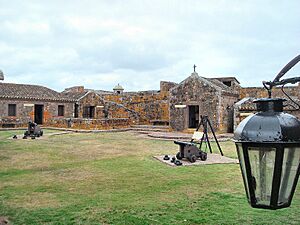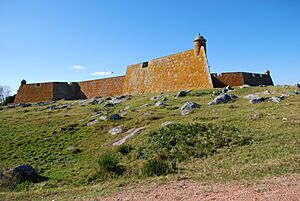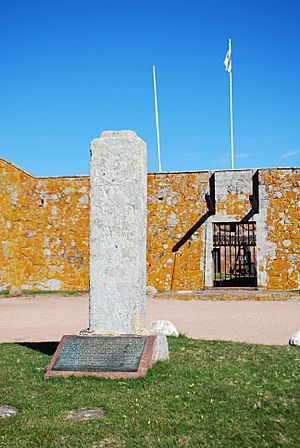Fuerte San Miguel (Uruguay) facts for kids
The Fuerte de San Miguel (which means San Miguel Fort) is an old military fort in the town of Dieciocho de Julio, in eastern Uruguay. The Portuguese built it in 1737. They used large, heavy stones to make its tall towers, thick walls, and strong defenses. These features helped the fort stand strong during battles against Spanish forces. The fort played an important role in Uruguay becoming an independent country.
Contents
Where is Fuerte de San Miguel?
The fort is located on Route 19. It is about 6 kilometers (3.7 miles) south of the Laguna Merin lake. It is also about 8 kilometers (5 miles) west of the town of Chuy. The fort sits on top of the Sierra de San Miguel mountain, which is 35 meters (115 feet) high. This area has many large valleys. The San Miguel River flows at the base of the mountain, but you cannot see it from the fort. In the distance, you can see mountains that form the border with Brazil.
History of the Fort
The Portuguese built Fuerte de San Miguel to watch the movements of Spanish soldiers. About 100 men were stationed there. In 1750, the Treaty of Madrid allowed Portugal to keep and strengthen the fort.
Before another treaty in 1761, Portuguese leaders ordered troops to the Laguna region. Their plan was to quickly build a strong defense line south of Fort San Miguel. This was to stop the Spanish invasion. In October 1762, Spanish Governor Pedro de Cevallos took over Colonia del Sacramento.
Around the same time, the Portuguese began building the Fortaleza de Santa Teresa nearby. This new fort was meant to be even stronger than San Miguel. However, in April 1763, Governor Ceballos captured San Miguel. The Spanish then made many improvements to it, turning it into a fully working fort.
In 1775, an engineer named Bernardo Lecocq strengthened the fort even more. This was because a British invasion seemed likely. The First Treaty of San Ildefonso in 1777 officially confirmed that the Spanish owned the fort. In 1797, the fort was made even stronger, reaching its peak as a military stronghold. This was done in case another war broke out.
After Uruguay became independent in 1828, the fort was no longer used. It was left alone and slowly fell into ruin. By 1891, plants covered the fort, and cracks appeared in its walls.
How the Fort Was Built and Rebuilt
The Portuguese started building Fuerte de San Miguel on October 17, 1737. It was first designed as a simple defense base. Military engineers like Brigadier José da Silva Pais and Captain Antonio Teixeira Carvalho helped with its construction. This fort is smaller and less perfect than the nearby Fortaleza de Santa Teresa. This is because there were not enough good granite stones available.
The first plan for the fort was a rectangular shape made of stone. It had two five-sided towers, called bastions, at the corners. By 1740, the fort had grown into a star shape with four five-sided bastions. This style is known as Vauban style. Inside, there were walls and buildings made of rough stone. There was also a chapel and a deep well. The total length of the walls was 300 meters (984 feet).
To get into the fort, people had to cross a drawbridge over a moat filled with water. On one side of the hill, there is a hidden outpost. It looks like a natural cave or animal shelter, but it has a small window facing east.
Over the years, after Uruguay became independent, the fort's walls began to crumble. However, Uruguayans were proud of the fort's history. It was important for their country's independence. So, in 1927, they decided to restore it. A committee of important people, including Gen. Alfredo R. Campos and historian Horacio Arredondo, started the work.
In 1933, the fort was rebuilt using the original plans and old building methods. They restored the Command House, the Parliament House, the chapel, the kitchen, and the Troop Barracks. In 1937, the fort was declared a National Monument of Uruguay. This helped to continue its restoration.
The area around the fort is also protected. You can see native animals like monkeys, birds, capybaras, and guazubira in the forests and marshlands.
What You Can See Today
The Uruguayan Army manages the fort, and it is always open to visitors. Inside, there is a Museum of Military History. Here, you can see a collection of old uniforms worn by soldiers who were stationed at the fort. The museum also shows how army uniforms have changed over time. You can also see paintings by the artist Emilio Regalía.
Near the fort, there is an inn called Hosteria Fortin de San Miguel. It was built in 1945 in the Spanish colonial style. It has 20 rooms and a large ballroom.
Gallery
See also
 In Spanish: Fuerte de San Miguel (Uruguay) para niños
In Spanish: Fuerte de San Miguel (Uruguay) para niños









